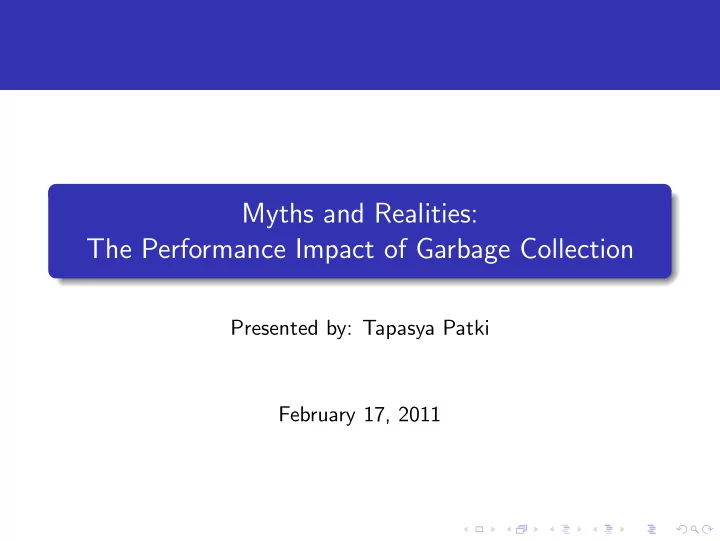

Myths and Realities: The Performance Impact of Garbage Collection Presented by: Tapasya Patki February 17, 2011
Authors
Motivation: Cost-Benefit Analysis
Motivation: To GC or not to GC Explicit Memory Management or Garbage Collection? Can GC ever improve application performance? Whole-heap collection or Generational collection?
Motivation: Some more questions Sensitivity to Heap Size Frequency of collection Cost of collection: Whole-heap or Nursery? Space tradeoff: SemiSpace or Mark-Sweep? Locality: L1, L2, TLB misses Influence of processor architecture on GC
Background: Allocation Strategies Contiguous append new object by incrementing a bump pointer speed of allocation, locality Free-list k size-segregated lists (binning) allocate new object in smallest size class internal fragmentation, faster compaction
Background: Collection Strategies Tracing transitive closure: roots ∪ remembered-set reclaim by copying live objects Reference Counting count number of references reclaim objects with no references
Background: Whole-heap GC Algorithms Algorithm Allocator Collector SemiSpace Contiguous Tracing MarkSweep Free-list Tracing RefCount Free-list Reference Counting
Background: Generational GC Algorithms Algorithm Nursery Mature GenSS SemiSpace SemiSpace GenMS SemiSpace MarkSweep GenRC SemiSpace RefCount write-barrier: to record pointers from mature-space to nursery size of nursery compaction of nursery survivors
Methodology MMTk in IBM Jikes RVM Java-in-Java design pseudo-adaptive compilation using application profiles (deterministic) immortal space for itself (compiler, classloader, collector) Arch CPU Freq RAM L1 L2 Athlon 1.9Ghz 1GB 64K both 512K P4 2.6GHz 1GB 8K D, 12K I 512K PPC 1.6GHz 768MB 32K D, 64K I 512K
Benchmarks Mutator Phase: application code, contains allocation sequence and write-barriers GC Phase SPEC JVM benchmarks
Results: javac
Results: Generational vs Whole-heap (Rough Sketch)
Results: Write Barrier
Results: Nursery Size Trend for GenCopy and GenMS (Rough Sketch)
Results: Architecture Influences Architecture Influences Crossover point: When SemiSpace outperforms MarkSweep Limited space versus Locality tradeoff
Results: Architecture Influences, PPC 1.6GHz
Results: Architecture Influences, Athlon 1.9GHz
Results: Architecture Influences, P4 2.6 GHz
Myths and Realities Contiguous is better than Free-list Allocation is 11% faster, total improvement 1% Locality improves mutator performance by 5-15% (SS vs MS) Tracing is usually better than Reference Counting Only live objects are touched Locality improves RC can be useful for mature objects, when most of the heap consists of live objects Sensitivity to Heap Size Determines collection frequency Small heaps: MarkSweep, Modest to large heaps: SemiSpace
Myths and Realities Generational better than Whole-heap Write-barrier over head is 1-14%, 3.2% average Collection time benefits outweigh the write-barrier overhead Locality of nursery: spatial Locality of mature objects: temporal Nursery size Fixed overhead of scanning roots (about 64KB) Need not be matched to L2 cache size (512KB) Should depend on fixed overhead (4-8MB) If large, collection cost degrades performance ( > 8MB)
Impact on the GC Research Community Compare generational GC with explicit memory management GC is competitive with explicit memory management 5x memory, outperforms 3x memory, 17% slower on average GC can do slightly better than explicit memory management in large heaps
Some more references www.cs.utexas.edu/users/mckinley/395Tmm/talks/May-4-MMTk.ppt M Hertz and E Berger, Quantifying the Performance of Garbage Collection vs. Explicit Memory Management, OOPSLA’05
Recommend
More recommend